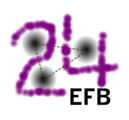Speaker
Description
In recent times, it has become clear that inclusive Deep Inelastic Scattering does not allow to fully understand few fundamental issues about the nuclear partonic structure, such as the origin of the EMC effect. These difficulties can be overcome considering a new generation of experiments at high energy and high luminosity [1] involving exclusive scattering processes. Among them, deeply Virtual Compton Scattering (DVCS) is a very promising direction for unveiling the 3 dimensional nuclear structure. The first experimental DVCS data considering an $^4$He target have become recently available at the Jefferson Laboratory (JLab) where, for the first time, the coherent [2] and incoherent channels of the process have been successfully disentangled .
The accuracy of the present and expected data is such to require sophisticated studies to properly evaluate conventional nuclear physics effects, using the state-of-the-art wave functions accounting for realistic nucleon-nucleon potential including three-body forces. Since the $^4$He nucleus is the lightest system showing the dynamical features of a typical atomic nucleus and realistic calculations, although challenging, are possible, this nucleus is a paradigmatic system. For both DVCS channels, we studied the handbag contribution to the process in impulse approximation. Within this scenario, for the coherent DVCS contribution [3], a convolution formula for the only leading twist Generalized Parton Distribution (GPD) describing the $^4$He partonic structure is derived in terms of the non-diagonal nuclear spectral function of $^4$He and on the GPD of the struck nucleon. A model for the off-diagonal spectral function, based on the momentum distribution corresponding to the Av18 potential [4], is used in the actual calculation together with a well known model as far as concerns the nucleonic GPD [5] . Then, the numerical results of this approach are compared with the experimental data published by the EG6 experiment at Jlab [2], showing an overall good agreement. The results obtained allow to conclude that the description of the present data does not require exotic arguments, such as dynamical off-shellness or non-nucleonic degrees of freedom.
Calculations of the relevant observables for the incoherent DVCS channel, starting from the DVCS cross section for an initially moving nucleon embedded in the $^4$He target, will be addressed. Finally, more refined nuclear calculations, with a view to the next generation of experiments at the JLab12 and at the future electron-ion collider, will be described.
[1] R. Dupré and S. Scopetta, Eur. Phys. J. A 52, 159 (2016).
[2] M. Hattawy, et al., CLAS collaboration, Phys. Rev. Lett. 119, 202004 (2017).
[3] S. Fucini, S. Scopetta, and M. Viviani, Phys. Rev. C. 98, 015203 (2018).
[4] M. Viviani, A. Kievsky, and A. S.Rinat, Phys. Rev. C 67, 034003 (2003).
[5] S. V. Goloskokov and P. Kroll, Eur. Phys. J. C 53, 367 (2008).




